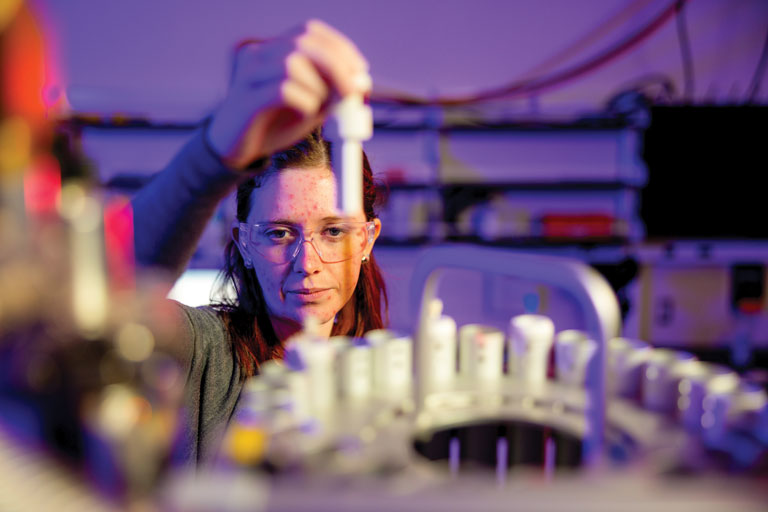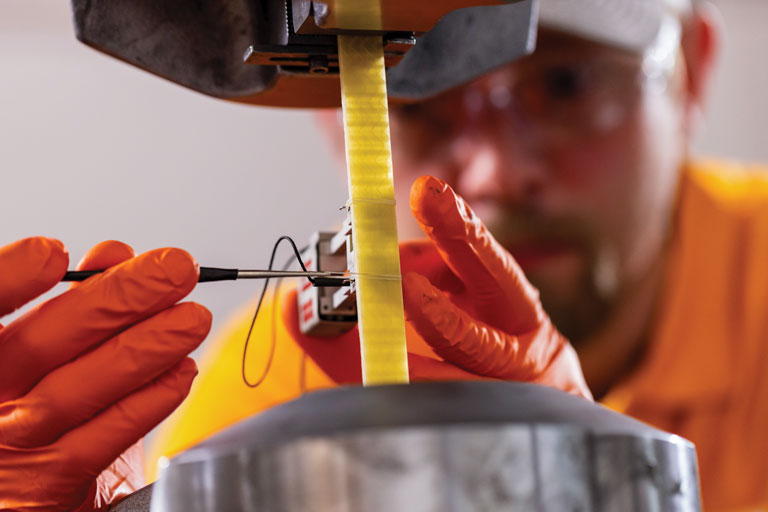Last summer, an interdisciplinary team spearheaded by Professor of Physics and Materials Science Alan Tennant and Professor of Materials Science Claudia Rawn brought a new opportunity to UT: a prestigious National Science Foundation Materials Research Science and Engineering Center. Now Tennant and Rawn serve the new center—named the Center for Advanced Materials and Manufacturing—as director and education and diversity director, respectively.
“The unique MRSEC model is a nexus for new science and new opportunities,” Tennant said. “We are leveraging that model to shape the future for students and the Southeast.”
New science takes many forms at CAMM as researchers pursue next-generation quantum materials and materials for extreme environments in addition to artificial intelligence tools and processes that can accelerate discoveries.
“Our research areas have implications for mobility, national security, aerospace, computation, carbon-free energy, and more,” Tennant said. “The MRSEC model synergistically brings these different facets together to change the game.”

The center’s Interdisciplinary Research Group 1, led by Physics and Astronomy Department Head Adrian Del Maestro, brings together physics, chemistry, materials science, electrical engineering, and computer science to study quantum materials. IRG2, led by UT–ORNL Governor’s Chair for Nuclear Materials Steven Zinkle, adds civil, environmental, and nuclear engineering to the mix to develop materials for extreme conditions including temperature, pressure, and radiation.
Both IRGs are using AI to transform their approach. Rawn, whose research falls into IRG2, said, “Traditionally we tested one extreme condition at a time. That was challenging enough. Now AI can process so much data efficiently, allowing us to couple conditions together to develop materials for extremes and to use extremes to develop new materials.”
Assistant Professor of Materials Science Yishu Wang, a member of IRG1, added, “Incorporating AI methods addresses the complexity problem inherent in quantum materials. AI can efficiently analyze vast datasets and identify patterns.” AI directly benefits her research, which uses neutron scattering to characterize quantum materials for computing and information processing.

New opportunities flow naturally out of the MRSEC model, which is built around a different way to lead and teach research. In contrast to the traditional academic model of a single investigator or faculty advisor connected to a group of students, CAMM immerses each faculty member, postdoctoral researcher, and student in an IRG. Students have multiple advisors and direct access to a large team with shared goals and varied expertise. “Interacting with so many people with different personal and professional backgrounds empowers students to work in creative ways, developing themselves and their interests,” Tennant said.
“Right now we have positions for 38 graduate and undergraduate students,” Rawn said. “New faculty and postdocs will come, and we’ll keep expanding.” The opportunities are not limited to UT students; Rawn is forging connections with schools around Tennessee that serve diverse student populations, including historically underserved communities. “We’ll provide summer programs and trainings open to students across the state,” she said.

CAMM leadership aims for every student to gain familiarity with AI. “The future workforce should be on the cutting edge of science and techniques,” Rawn said. The team is also developing entrepreneurship training, equipping students and start-ups alike to join East Tennessee’s innovation ecosystem.
“The Southeast is a rising region for innovation. East Tennessee is home to world-class facilities and partners, including Oak Ridge National Laboratory,” Tennant said. CAMM researchers also have access to state-of-the-art facilities and equipment on campus, including a world-class ion beam.
Industry advisors and partners will bring real-world problems to help guide research trajectories and support the translation of discoveries into commercial products and services. CAMM will also make its experimental capabilities and AI tools open to the broader scientific community.
“The MRSEC model is how we’ll produce researchers and innovators who understand big-picture impacts on industry and national needs. They’ll be empowered with skills and knowledge others on the market won’t have yet,” Tennant said. “This is our opportunity to create something significant. It’s a privilege to be part of this.”
